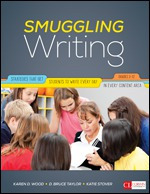Use this sample assessment from Teaching Literacy in the Visible Learning Classroom, Grades 6-12, to test students’ understanding of literary devices.
Use this sample assessment from Teaching Literacy in the Visible Learning Classroom, Grades 6-12, to test students’ understanding of literary devices.
In this episode on the All About Literacy podcast, co-authors of Comprehension Dr. Doug Fisher and Dr. Nancy Frey talk about the connections between text selection, text complexity, disciplinary literacy, and adolescent learning.
On this LLCN Brief podcast episode, Visible Learning for Literacy co-author Doug Fisher shares his perspective related to Feedback and the research surrounding the use of feedback to influence growth.
Summarizing is a great way to know if a student is understandning the main point of the reading. In this activity from The Big Book of Literacy Tasks, Grades K-8, the student will write a news story to another student explaining the most important points to know from the text read the day before.
Read this article from ILA's "Literacy Across Disciplines" by Douglas Fisher & Nancy Frey, authors of Comprehension. Inside, the authors discuss their vision for not only deepening students' understanding of complex texts, but energizing and inspiring students to read passionately.
We know that writing skills reinforce reading skills, but what’s the best way to capitalize on this beneficial relationship? By flipping the traditional “reading lesson first, writing lesson second” sequence, Colleen Cruz, author of Writers Read Better: Narrative and Nonfiction, ingeniously helps you make the most of the writing-to-reading connection with carefully matched, conceptually connected lesson pairs. Attend this webinar to discover how you can do the same and establish a healthy reciprocity that effectively and efficiently develops students’ literacy skills.
Learn the four kinds of readers rules of notice from Jeffrey Wilhelm, author of Diving Deep Into Nonfiction, Grades 6-12, and how they can accelerate comprehension.
Shared from Fun-Size Academic Writing for Serious Learning, here are 25 ways to use the essays your students write to further the writing process.
You can post this list of essential academic words from Academic for College and Career Readiness, Grades 6-12, along with their definitions, in your classroom or give a copy to every student.
These graphic organizers from The Nonfiction NOW Lesson Bank are tools that students can use throughout a reading and writing unit to help clarify their thinking.

In this lesson from Smuggling Writing students learn to gather information from video and audio through structured note taking and collaborative discussion.

Taken from Grammar Keepers these two-page lesson plans on they're, their, and there will help your students learn once and for all how to avoid misusing these homonyms.